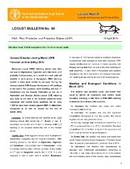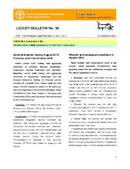General situation during May 2019 Forecast until mid-July 2019
Moroccan Locust (DMA) hopper development was in progress in Kazakhstan and the Russian Federation while it was coming to an end in Azerbaijan, Georgia as well as in southern Central Asian (CA) countries where fledging,...
General situation during April 2019 Forecast until mid-June 2019
Moroccan Locust (DMA) hopper development was in progress in all Central Asian (CA) countries except the Russian Federation as well as in Azerbaijan and probably in Georgia. Because of the cool and wet weather, hopper development was delayed in most countries, and control operations were carried out on significantly...
General Situation during March, 2019 Forecast until mid-May 2019
Moroccan Locust (DMA) hatching started later than last year in Afghanistan, Tajikistan and Uzbekistan (and probably Turkmenistan), as a result of a cool and wet weather in early spring. In Kyrgyzstan, DMA hatching started in early April, similar to last year. During the forecast period, DMA hopper development will continue...
General situation from November 2018 to January 2019 Forecast until mid-March 2019
Natural cycles of the three locust species – Italian Locust (CIT), Migratory Locust (LMI) and Moroccan Locust (DMA) ended in late summer/early autumn in all countries with eggs laid in the soil, where they overwinter (embryonic diapause). During the forecast period, no development is expected as no hatching will occur. ...
General situation during August 2018. Forecast until mid-October 2018
Italian Locust (CIT) mating and egg-laying continued in Armenia, Georgia, Kazakhstan, Kyrgyzstan, Russian Federation and Tajikistan. Migratory Locust (LMI) mating and egg-laying continued in Kazakhstan, Uzbekistan and the Russian Federation. During the forecast period, locusts will complete their natural cycle in most areas. Control operations ended in all countries; since...






